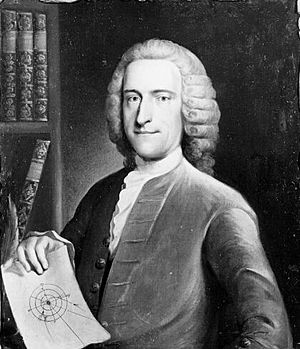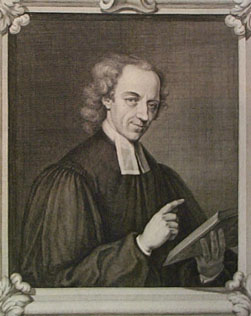William Whiston facts for kids
Quick facts for kids
William Whiston
|
|
|---|---|
 |
|
| Born | 9 December 1667 Norton-juxta-Twycross, Leicestershire, England
|
| Died | 22 August 1752 (aged 84) Lyndon, Rutland, England
|
| Nationality | English |
| Alma mater | Clare College, Cambridge |
| Known for | Translating the works of Josephus, catastrophism, isoclinic maps, work on longitude |
| Scientific career | |
| Fields | Mathematics, theology |
| Institutions | Clare College, Cambridge |
| Academic advisors | Isaac Newton Robert Herne |
| Notable students | James Jurin |
| Influences | David Gregory Isaac Newton |
| Signature | |
William Whiston (born December 9, 1667 – died August 22, 1752) was an English thinker who studied many subjects. He was a theologian (someone who studies religion), a historian, a natural philosopher (like an early scientist), and a mathematician. He played a big part in making the ideas of Isaac Newton popular.
Today, Whiston is best known for two things. First, he helped create the Longitude Act in 1714. This law offered a big prize to anyone who could find a way to figure out a ship's longitude (its east-west position) at sea. Second, he made important translations of the writings of Josephus, an ancient Jewish historian. These translations are still used today!
Whiston took over from his teacher, Isaac Newton, as the Lucasian Professor of Mathematics at the University of Cambridge. But in 1710, he lost this job and was kicked out of the university. This happened because he had different religious ideas than the official church. For example, he didn't believe in the idea of eternal punishment in hell. He also disagreed with the church's teaching about the Trinity, which he thought came from older, non-Christian beliefs.
Contents
Early Life and Education
William Whiston was born in a place called Norton-juxta-Twycross in Leicestershire, England. His father was a church leader there. William was taught at home for a while because he wasn't very healthy. He also helped his father, who was blind, by writing things down for him.
Later, he went to Queen Elizabeth's Mercian School and then to Clare College, Cambridge in 1686. He was very good at math. He earned his first degree in 1690 and became a Fellow (a kind of teacher and researcher) at the college in 1691.
In 1693, William Whiston became a priest. He later became a rector (another type of church leader) in Lowestoft in 1698.
Working with Isaac Newton
Whiston first met Isaac Newton in 1694. At first, Newton's ideas were hard for him to understand. But after reading about Newton's ideas from another mathematician, Whiston decided to learn Newton's famous book, Principia Mathematica. He and Newton became friends.
In 1701, Whiston left his church job to teach math at Cambridge in Newton's place. The next year, in 1702, he officially took over from Newton as the Lucasian Professor of Mathematics. This was a very important position. He also worked with another professor, Roger Cotes, teaching about science and experiments.
Science and Religion
Whiston believed that science and the Bible could explain each other. He thought that big events mentioned in the Bible, like floods or eclipses, could be understood using scientific ideas. He also believed that comets (space rocks with tails) had caused major disasters on Earth in the past.
His most famous book on this topic was A New Theory of the Earth (published in 1696). In this book, he suggested that the great flood described in the Bible was caused by a comet hitting Earth. The famous philosopher John Locke liked Whiston's ideas, saying they brought "new things to our thoughts."
Whiston also believed that comets returned regularly, like Edmond Halley did. In 1736, he even predicted that a comet would hit Earth on October 16 of that year, causing the world to end! This made many people in London very worried, and the Archbishop of Canterbury had to tell everyone it wasn't true to calm them down.
Disagreements with Newton
It's not clear how close Whiston and Newton really were. Some people think their friendship wasn't very strong and got worse when Whiston started writing about biblical prophecies.
Whiston was never a member of the Royal Society, a famous group of scientists. He thought it was because he was seen as a "heretic" (someone with unpopular religious beliefs). He also felt that Newton didn't like having a student who thought for himself.
Losing His Job
Whiston's different religious views caused him a lot of trouble. He studied old church writings and became convinced that the early Christian church had different beliefs about God than the church of his time. He disagreed with the Nicene Creed, a main statement of Christian belief.
Because of his different ideas, especially about the Trinity, he became very unpopular with church leaders. In 1710, he was removed from his professorship and expelled from Cambridge University. He tried to get a hearing to defend himself, but the queen at the time, Queen Anne, avoided the issue.
"Primitive Christianity"
After losing his university job, Whiston started a group to promote what he called "primitive Christianity." He believed this was the way Christianity was practiced in the very early days. He gave talks in London and other cities, sharing his ideas.
He believed strongly in the supernatural parts of Christianity, like prophecies and miracles. He also thought that some practices from the early church, like anointing the sick, should still be done. Around 1747, he left the main Anglican church and became a Baptist because he disagreed with some of their beliefs.
Public Speaker and Writer
Whiston became a popular speaker in London. He gave lectures about science, especially astronomy and physics, often at coffee houses. He would show experiments during his talks.
He also published many books and charts. In 1712, he published a chart of the Solar System showing the paths of many comets. He even lectured about a total solar eclipse that happened in 1715, explaining it as both a natural event and a sign.
Solving the Longitude Problem
In 1714, Whiston played a key role in getting the Longitude Act passed. This law created the Board of Longitude and offered a big prize to anyone who could find a reliable way to determine longitude at sea.
Whiston worked with another person, Humphrey Ditton, and they published a book called A New Method for Discovering the Longitude, both at Sea and Land. For the next 40 years, Whiston kept suggesting different ways to solve the longitude problem. Many people made fun of him for this, but he was determined. One of his ideas involved using Earth's magnetic field, and he even created one of the first isoclinic maps (maps showing lines of equal magnetic dip) of southern England in 1719.
Personal Life
William Whiston married Ruth Antrobus, whose father was his old headmaster. They had a happy family life. Whiston died in Lyndon Hall, Rutland, at the home of his son-in-law, on August 22, 1752. He had four children: Sarah, William, George, and John.
Important Works
Whiston spent much of his later life writing and debating about religion, math, and history. Some of his important works include:
- "Primitive Christianity Revived" (1711–1712): In this five-volume work, he explained his religious views, especially his ideas about the early church.
- "The Genuine Works of Flavius Josephus the Jewish Historian" (1737): This was his famous translation of the complete works of Josephus, an ancient Jewish historian. This translation is still widely used today.
- "Primitive New Testament" (1745): His own version of the New Testament.
- Memoirs (1749–1750): His autobiography, where he wrote about his life.
See also
 In Spanish: William Whiston para niños
In Spanish: William Whiston para niños
- Noah's Flood
- Catastrophism
- Biblical prophecy
- Dorsa Whiston, a feature on the Moon named after him




